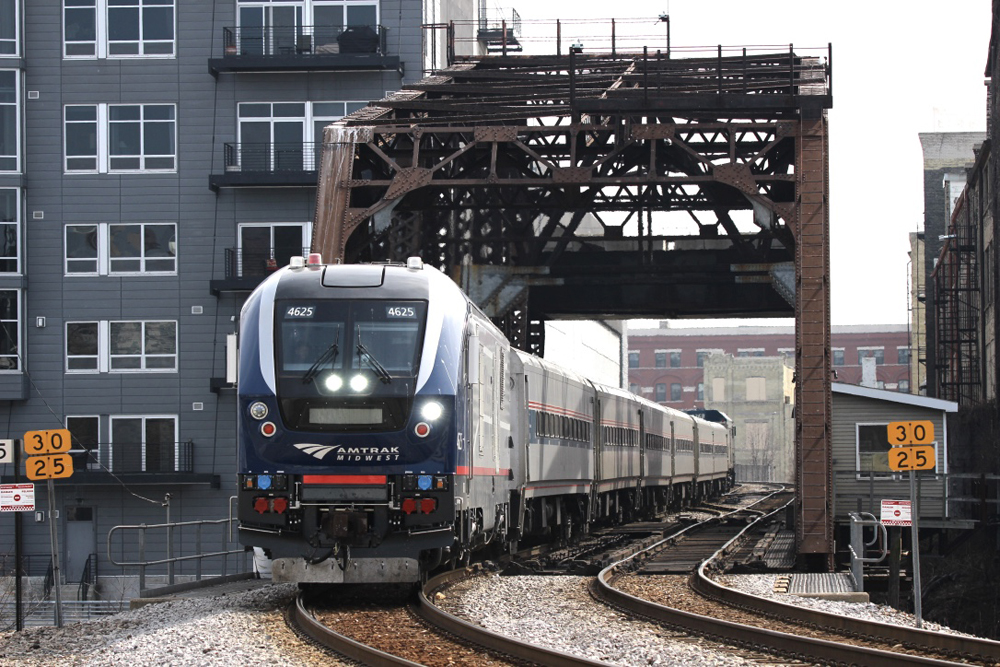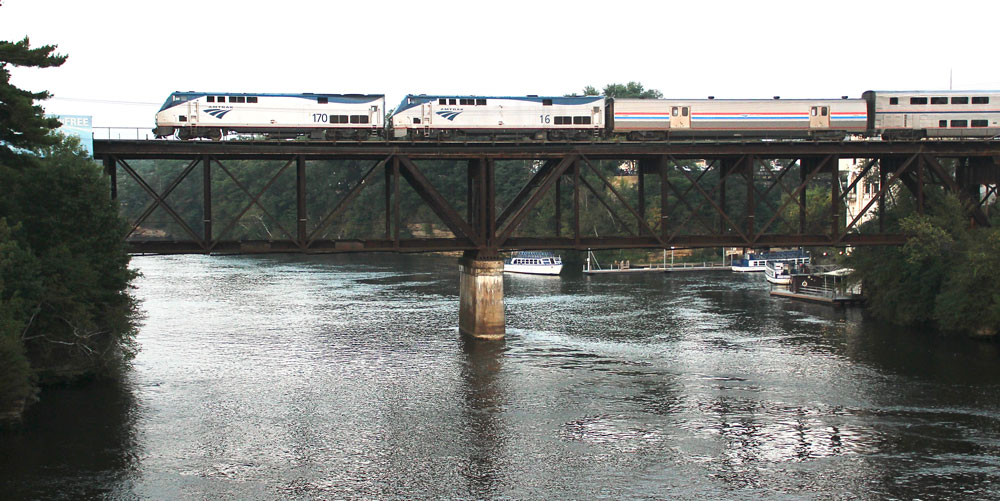
Five routes in Wisconsin — including both the state’s existing Amtrak lines, which seek increased service — are among those selected for the Federal Railroad Administration’s Corridor Identification and Development Program, according to members of Congress across the country. Selection provides funding for studies that are a prelude to new or expanded Amtrak service.
In all, nine more routes were announced today (Wednesday, Dec. 6):
— Phoenix-Tucson, Ariz.
— Fort Collins-Denver-Pueblo, Colo.
— Nashville-Memphis, Tenn.
— Pittsburgh-Philadelphia, Pa.
— Green Bay, Wis.-Milwaukee-Chicago
— Milwaukee-Madison-Eau Claire, Wis.
— Eau Claire-Twin Cities
— Milwaukee-Chicago (increased Hiawatha service)
— Chicago-Milwaukee-La Crosse-Twin Cities (increased service on the Empire Builder route)
Those routes join 14 announced on Tuesday [see “North Carolina, Ohio corridors lead list …,” Trains News Wire, Dec. 5, 2023]. The organizations sponsoring the applications for each route receive a $500,000 grant to formulate a Service Development Plan for the corridor. More on the Corridor ID program is available here.
U.S. Sen. Tammy Baldwin (D-Wis.) announced the Wisconsin selections, which will see $2.5 million for the studies go to the state’s Department of Transportation. Baldwin said in a press release that she was “excited to see these plans for passenger rail move forward.”

As outlined on the Amtrak ConnectsUS website, the Green Bay route would extend an existing Hiawatha train, with new intermediate stops in Fond Du Lac, Oshkosh and Appleton, Wis.
The increase sought on the Empire Builder route is apparently in reference to already-planned second daily train on that route, expected to launch next year [see “Second train between Twin Cities and Chicago …,” Trains News Wire, Nov. 3, 2023].
Rep. Greg Stanton (D-Ariz.) announced that the Phoenix-Tucson corridor had been selected, with the Arizona Department of Transportation, which had sponsored the application, to receive the funding for the study. The Arizona DOT has provided an additional $3.5 million in project planning funds. Phoenix has not been served by Amtrak since 1996, when Union Pacific eliminated a route into the city and the Sunset Limited shifted its stop to Maricopa, more than 30 miles south.
Stanton noted at a hearing earlier this year that Phoenix is the largest city in the U.S. without passenger rail service. “As other communities have gained access to passenger rail, they’ve experienced significant new economic opportunities,” he said. “But Arizona has missed out.”
Colorado’s project is arguably one of the best-prepared corridors under consideration, with an existing governmental body, the Front Range Passenger Rail District, to support design, finance, and construction of a 160-mile. That group has already begun developing the Service Development Plan required under the Corridor ID program; it is expected to be completed next year.
U.S. Rep Joe Neguse (D-Colo.) announced the funding for the Front Range corridor, which would also serve Boulder and Colorado Springs, as well as other intermediate locations.
“This is yet another example of the ways in which the historic Bipartisan Infrastructure Law is delivering for the people of Colorado,” Neguse said in a press release. “This corridor stretches across more than 160 miles, connecting 13 of the most populous counties across the state and acting as a transportation ‘spine’ for the Front Range. I am excited to see this project become a reality for our growing communities.”
Inclusion of the Memphis-Nashville corridor follows Tuesday’s announcement of selection of a Nashville-Chattanooga-Atlanta route by Chattanooga Mayor Tim Kelly.
“Passenger rail service linking Tennessee’s major cities will be a major economic shot in the arm and will invigorate travel and tourism across our state,” U.S. Rep. Steve Cohen (D-Tenn.) said in a statement. “… Once this service is in operation, much of the country will be accessible by rail from Memphis. This is a very big deal, and I look forward to working with stakeholders in all of the route’s proposed cities to continue to move this project forward.”
The Philadelphia-Pittsburgh corridor announcement was included in a release from Pennsylvania’s two senators announcing funds for infrastructure upgrades to accommodate a second daily Amtrak Pennsylvanian [see “Pittsburgh-Harrisburg route improvements …,” News Wire, Dec. 7, 2023].
The selection of 23 routes now means $11.5 million for route studies has been committed under the Corridor ID program. It is unknown how much funding is available, when the FRA might release the full list of routes selected, or how many other routes might be announced by legislators in the interim.
— Updated Dec. 7 at 8:45 a.m. to include Philadelphia-Pittsburgh corridor.














Charles: I thought CHI-MKE-Madison, implemented with credible frequencies had great potential. Why do you characterize the plans for it “half-baked”? Then SecTrans Ray LaHood was a huge supporter and I thought he was a pretty level-headed guy.
Mr Landey neglects to mention Wisconsin’s botched opportunity to expand rail passenger service during Scott Walker’s tenure as governor, nor the billions spent upon the rebuilding of Milwaukee County’s major interchanges; both missed the chance for long-term transportation progress.
While not personally directed at Mr Landey, his little Brookfield-West Allis RT exactly exemplifies the social-racial inequalities perpetuated by long-standing transportation policies (read politics). Those with long memories recall the era of “urban renewal” and Milwaukee’s mayor Maier, who thinking he was a progressive along the lines of Robt. Moses, bulldozed thru “poorer” neighborhoods to allow suburban traffic (also paved over the Milwaukee Electric ROW into downtown).
My dear friend — look up the traffic counts in the Zoo Interchange IH 94 and IH 41, combined with the associated improvements to USH 18, STH 59, STH 181, STH 100, and Watertown Plank Road. Compare those counts to ALL OF AMTRAK nationwide. Then tell me who serves who.
Get back to me when you have the answers.
Robert Moses had a blind spot against rail transit that I can’t endorse, but he also had a number of very successful and appreciated projects, from the Niagara Frontier to Suffolk County.
I did not live in Wisconsin when Mayor Maier was in office. I’m not aware (in retrospect) of any transportation issues that came up during his term in office. The various criticisms I’ve read about him are outside the scope of these pages. Since you brought it up, seeing what a squalid mess his successors have made of Milwaukee, Maier seems to look good in hindsight.
Scott Walker supported the Hiawatha and the program to rebuild or build all of the stations along the route. He was opposed to the Madison train. Having seen the half-baked plans with my own eyes I fully concurred. I live along the route through eastern Waukesha County. The proposal was a loser.
Finally, seeing that all Tagos in USA are now out of service, Scott Walker’s decision to sell them of seems to have worked out.
Walker didn’t sell the Talgos, he broke a contract and paid a $48m penalty. Plus loss another $48m in funding.
Don’t worry about who will pay for it other than the Pitts-Philly route none of this will ever see the light of day the monied influences who control our lives will see to that!
Nah, at least Scranton is happening. Locally we will NOT let this issue go, even if some heads of the rich need to roll.
OK, I’ll ask the question. Charles, crickets?!? Where is the predictable outcry of tax dollars possibly being spent to expand 5 routes in Wisconsin. I certainly hope only Wisconsin taxpayers fund these projects.
Unlike California we don’t botch our projects.
Wisconsin DOT has a long and a proud record of completing projects on time, on budget.
I’d know, I just this morning drove to West Allis and back home, via WisDOT’s magnificent and competent IH 94/ IH 41/ IH 894 Zoo Interchange in western Milwaukee County. On time, on budget, and solidly built.
Yeah, sending back those Talgo units only cost the taxpayers of Wisconsin about 96 million in lost funding and penalties. But , luckily the progressive voters are dragging Wisconsin, kicking and screaming into the 21st century.
Wisconsin paid $40 million to Talgo for the two trainsets and they settled for $9.7 million for the final *unless* the trainsets were sold to someone else, in which Wisconsin would get the money. The rest of the $180 million came from a Federal stimulus package.
To satisfy any expansion, Amtrak will need lots of new cars and locos. Given their current (non)success with new equipment purchases – late, defects, design problems – going to be a long time and quite expensive to equip new train routes.
A route along the Front Range needs to connect with the Southwest Chief. Expanded service between Chicago and the Twin Cities needs to connect to Duluth.
While a circuitous route between Memphis and Chattanooga via Nashville (381 miles) is proposed, the direct route via Huntsville, Alabama (2023 pop.: 235,005) is 310.7 railway miles remains barren of passenger train service since 1968.
Meanwhile, city planners of Nashville are proposing eliminating trackage offering a direct route to Chicago that curves the north side of Downtown Nashville and the Tennessee State Capitol from the Gulph to crossing of the Cumberland River. This could complicate the routing of future passenger service to the north, using a freight bypass away from Downtown just like the Phoenix area.
Just spoke to Nashville City Planning Office on the phone today, they’re insisting they have no track removal plans, but if ai could provide them a “project ID” they could provide more info lol.
My fingers zigged when they should have zagged. Track capacity needs to be expanded between Tower A5 and Rondout to make that happen where Metra, CPKC, and Amtrak are vying for space. What makes you think, Sen. Baldwin, that the folks in those suburbs will be any more willing to have new sidings put down that will get the ROW closer to their homes then they were the last time? What makes you think ILDOT has any more spine to withstand political pressure than they were the last time?
Suburban NIMBY’s don’t matter. 🤷🏻♂️🤷🏻♂️
Add new frequencies to the Hiawatha Service? Really? Sen. Baldwin dear, don’t you remember what happened when the Illinois and Wisconsin DOTs tried to accomplish that some 5 years ago? Don’t you remember the huge fight put up by the tony Chicago suburbs of Glenview and Lake Forest put up? And remember who won? Remember that ILDOT caved to the political pressure? Track capacity needs to be expaned